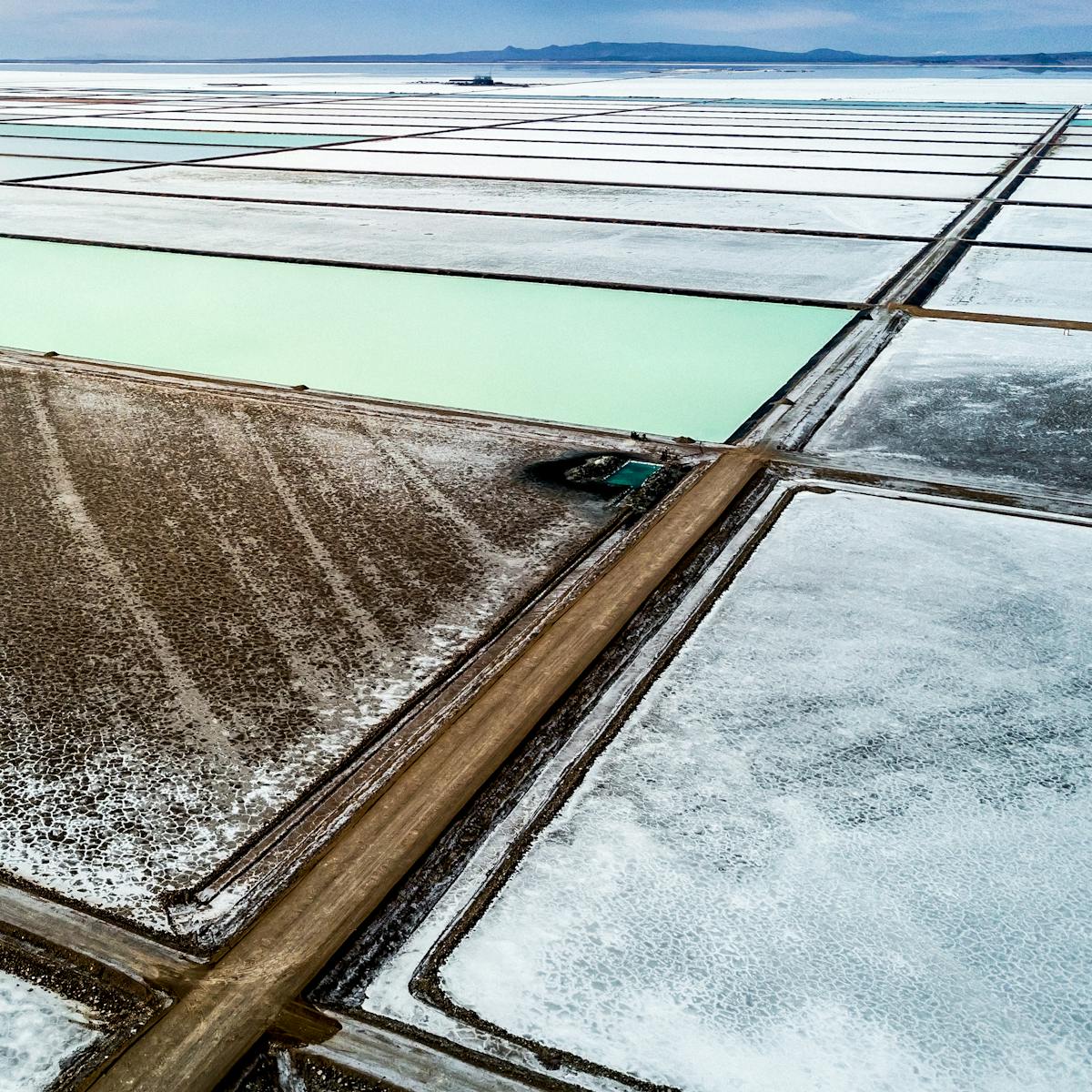Lithium batteries are championed as a key component of the technology that will solve our climate woes, and the world’s rush for so-called ‘white gold’ is being well documented. But the origins of the lithium Laura Grace Simpkins swallows daily are less clear. If we don’t know the provenance of our pills, how can we make informed decisions about them?
Finding out where my lithium comes from
Words by Laura Grace Simpkinsphotography by Matjaž Krivicaverage reading time 6 minutes
- Serial

In 2019 National Geographic ran an article by journalist Robert Draper and photographer Cédric Gerbehaye about the Bolivian government’s dreams of cashing in on the rush for so-called ‘white gold’. I take that, I thought, flipping through the glossy pages of the magazine.
I was stopped short by one photograph in particular: an aerial shot of Llipi lithium plant’s evaporation ponds. All golds and turquoises and diamonds and jades, they were crudely cut jewels indelicately pasted onto the crown of Bolivia’s Salar de Uyuni, the largest continuous salt flat in the world, at 10,582 sq km. I’d never seen a place, or even photographs of a place, quite like it.
I managed to narrow and widen my eyes simultaneously, torn between admiring the sheer scale, technological sublimity, and total brazenness of the human intervention in the landscape and lamenting how it unquestionably spoiled the desert’s untouched, ethereal beauty.
Although I knew about its stony origins, I’d never properly considered where the lithium I took came from. I’d only ever interacted with it as a convenient and aesthetically pleasing pressed powder and wondered what it was doing to me. I had a new and promising lead. My investigation was back on.
Reading the article, I learned that lithium mining was causing unprecedented problems on molecular, ecological, social, political and global scales.
I watched Cédric Gerbehaye’s short film ‘The Rush for White Gold’. I witnessed the pipes that had been drilled into the Salar’s crusty rim, the rush of the brine cascading out of them, the sparkle of its surface glinting seductively in the sun.
The scale of the operation Gerbehaye had captured via drone was vast, mesmerising. A softly coloured shot of the Andes, the lilacs and blues of a fading bruise, spliced in between the more industrial scenes, rendered the mountains laughably small in comparison.
Lithium gets pumped out from underneath the salt flats, and now here it is, circulating in the subterranean lagoons of my body.
After that I looked at myself and squinted. What I saw was an afterimage of Gerbehaye’s effervescent brine.
Lithium gets pumped out from underneath the salt flats, I marvelled, and now here it is, circulating in the subterranean lagoons of my body. I soon became convinced I could actually see bright, reflective specks of lithium drifting beneath my skin, moving with the current of my bloodstream.
The philosopher Timothy Morton would call this type of realisation ‘ecognosis’. In his book ‘Dark Ecology’ he explains that ecognosis is “the uncanny realisation that we are surrounded and penetrated by other entities such as stomach bacteria, parasites, [and] mitochondria”. Morton’s ecognosis can halt “anthropocentric mania” and can be used to harness environmentalist change. Ecognosis comes with a health warning, though. Morton says it can sometimes precipitate depression.
I decided to risk it. I wanted to find out where my lithium was coming from and I wanted to know if it was part of the infinite number of problems Robert Draper had sketched out in his article.
Some sourcing speculation
I went back to the Priadel packet. Neither on the cardboard box nor on the foil wrapper could I locate a country of origin. How is this allowed? I fumed. I know where my toothbrush and my trainers and my teabags are manufactured, but not my medication?
Finding out where my lithium comes from proved impossible. I even contacted the pharmaceutical company that supplies and distributes it, Essential Pharma, who replied that the source of their materials could not be disclosed “because the information is commercially sensitive”. Why all the mystery? I thought. What is there to hide?
By that point, I knew pharmaceutical companies couldn’t patent lithium. They’d rather not bother with it altogether because it doesn’t make them enough money. In September 2020 Essential Pharma tried pulling Priadel, their standard product, to allegedly bump sales of their more expensive (yet identical) lithium range. Maybe the secrecy wasn’t really about competition. Maybe it was to do with where they got it from.
I turned to the medical literature. In over 50 years since lithium carbonate’s approval in the UK, very few psychiatrists, historians or medical journalists, other than making vague references to “spa waters”, “petalite ore” and “salt flats”, have seriously addressed how lithium is obtained. Why is it so hard to find out? Why does no one else care?
I know where my toothbrush and my trainers and my teabags are manufactured, but not my medication.
I ventured into what was, for me, uncharted territory. I spent Friday nights and my weekends scrolling through mining websites, statistics and bar charts.
For decades, lithium was mined solely for medicinal purposes, in relatively small quantities. Over the last ten years, that’s radically changed. Fuelled by the supposedly “green transition” of the Global North, the movement away from fossil fuels to ‘cleaner’ alternatives, in 2019 approximately 65 per cent of mined lithium was for batteries, with up to 5 per cent for medication.
I began to speculate.
The top lithium-exporting countries that year were Australia, Chile, China and Argentina. I figured it was more likely my lithium came from brine; it costs a lot to process lithium carbonate from hard rock and the pharmaceutical companies wanted it as cheap as possible. That ruled out Australia, as well as China, leaving Chile and Argentina serious contenders.
Even Bolivia, whose white-gold rush was more of a white-gold crawl, wasn’t out of the realms of possibility. Together, Chile, Argentina and Bolivia are known as the ‘Lithium Triangle’. Over 75 per cent of the world’s reserves are said to be stored there. Bolivia alone is forecast to contain 50 per cent of the global total.
With no way of knowing where my lithium came from for certain, I decided the next stage of my investigation would take me to Bolivia. I had been inspired by Gerbehaye’s photographs of the Salar de Uyuni, after all. My ecognostic realisation had made me aware that having a bipolar diagnosis and taking lithium didn’t solely impact me. There was the rest of the world to put back into the picture.
About the contributors
Laura Grace Simpkins
Laura Grace Simpkins writes and performs about herself, madness and death. Her writing has been published by the Guardian, New Scientist and the British Medical Journal’s Medical Humanities, as well as broadcast on BBC Radio. She is currently working on her first book.
Matjaž Krivic
Matjaž Krivic is a documentary photographer capturing stories of people and places, primarily focusing on environmental issues. For over 25 years he has covered the face of the earth in his intense, personal and aesthetically moving style that has won him several prestigious awards. The past six years he has been immersed in the visual documentation of the lithium industry and also how companies and even countries are essentially washing away the climate sins of the past to create a greener and sustainable future.

